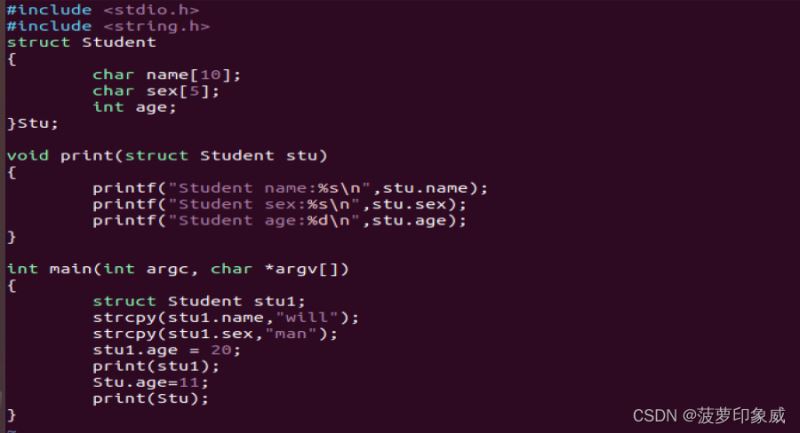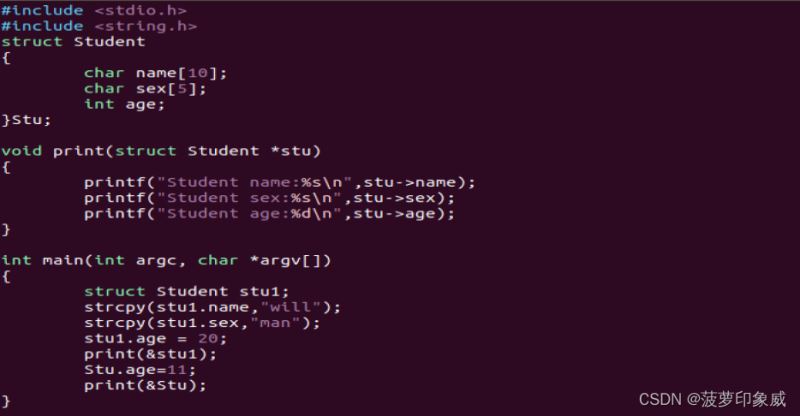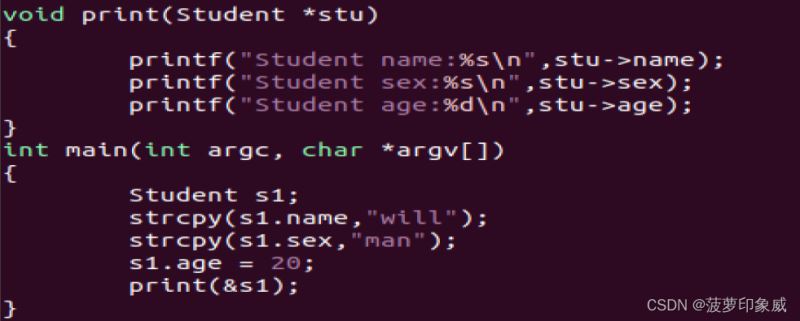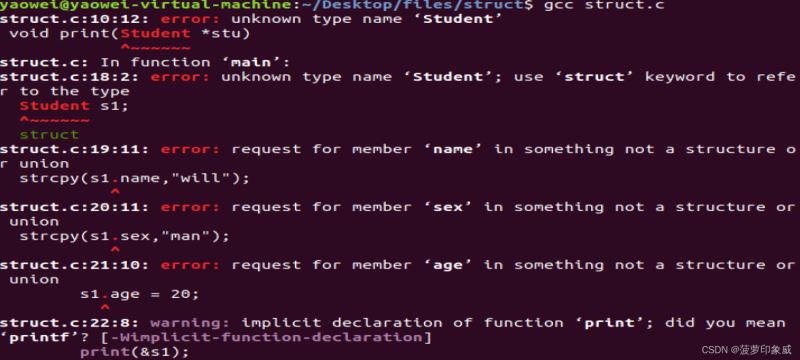这篇文章给大家分享的是有关C语言中结构体是什么的内容。小编觉得挺实用的,因此分享给大家做个参考,一起跟随小编过来看看吧。
一.结构体定义
C语言结构体由一系列相同或者不同类型的数据构成的集合,结构体类型就是以struct关键字定义的数据类型。
结构体的格式如下:
struct 结构名称 { 结构体所包含的数据成员,包括变量数组等} 结构变量 ;//结构变量可以指定一个或多个举例:
struct Student{char name[10];char sex[2];int age;}Stu二.实例演示
先看下结构体变量如何初始化

#include <stdio.h>#include <string.h>struct Student{ char name[10]; char sex[5]; int age;}Stu = {"Mike","man",22};int main(int argc, char *argv[]){ printf("name:%s\nsex:%s\nage:%d\n",Stu.name,Stu.sex,Stu.age);}初始化结构体变量很简单,直接在结构体变量后面赋值。
结果:

结构体作为函数参数
#include <stdio.h>#include <string.h>//定义Student结构体struct Student{ char name[10]; char sex[5]; int age;}Stu;void print(struct Student stu){ printf("Student name:%s\n",stu.name); printf("Student sex:%s\n",stu.sex); printf("Student age:%d\n",stu.age);}int main(int argc, char *argv[]){ struct Student stu1; strcpy(stu1.name,"will"); strcpy(stu1.sex,"man"); stu1.age = 20; print(stu1); //Stu Stu.age=11; print(Stu);}
从这个示例可以看出:将结构体作为参数传入函数,定义结构体时,我们可以在;前面定义结构体变量, 这样就不需要再定义结构变量,如:struct Student stu1;假设stu1在定义结构体时就定义变量,那么就可以直接赋值。
结果:

可以看出第二个学生打印,因为在定义结构体时就已经定义结构变量,所以可以直接赋值。
结构体指针
实例演示,传入结构体指针

#include <stdio.h>#include <string.h>struct Student{ char name[10]; char sex[5]; int age;}Stu;void print(struct Student *stu){ printf("Student name:%s\n",stu->name); printf("Student sex:%s\n",stu->sex); printf("Student age:%d\n",stu->age);}int main(int argc, char *argv[]){ struct Student stu1; strcpy(stu1.name,"will"); strcpy(stu1.sex,"man"); stu1.age = 20; print(&stu1); Stu.age=11; print(&Stu);}这里的实例和上面例子的区别主要是:
1.将定义的变量改为指针struct Student *stu。
2.指针赋值时使用->。
3.使用打印函数时,改为取地址。
结果一致
三.typedef struct 和 struct的区别
1、声明不同
1)、struct:struct可以直接使用结构体名字声明结构体。
2)、typedef struct:typedef struct为修饰结构体,结构体有了别名,通过结构体别名声明结构体。
2、访问成员变量不同
1)、struct:struct定义的结构体变量,可直接访问结构体成员。
2)、typedef struct:typedef struct定义的结构体变量,不可直接访问结构体成员,必须显式的通过结构体变量来访问成员。
3、重新定义不同
1)、struct:想重新定义struct结构体的话,必须重写整个结构体。
2)、typedef struct:想重新定义typedef struct结构体的话,可以通过别名来继承结构体进行重新定义。
举例:

可以看到:
使用typedef struct定义的结构体,我们通常是使用别名进行操作,而且在使用时也简化了使用方法,例如:Stu s1,相当于声明对象一样,如果使用struct,那么就要写成struct Student stu1;。
如果直接使用结构体名称那么会报错:
错误示例:
报错结果:
改回别名操作,结果:

感谢各位的阅读!关于“C语言中结构体是什么”这篇文章就分享到这里了,希望以上内容可以对大家有一定的帮助,让大家可以学到更多知识,如果觉得文章不错,可以把它分享出去让更多的人看到吧!











